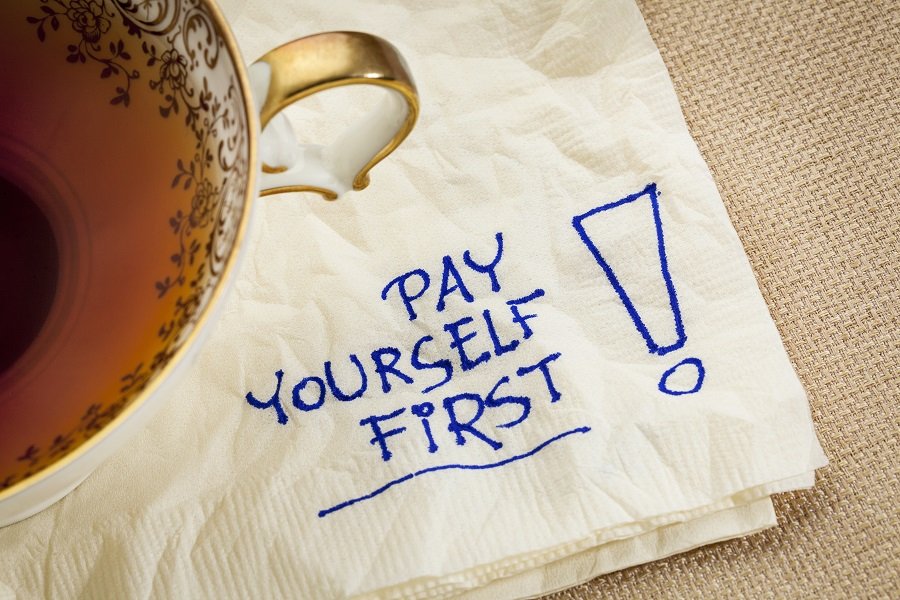Pay Yourself First: How and Why

Table of Contents
What Does it Mean to Pay Yourself First?
A common expression among Personal Finance experts is to, ‘Pay Yourself First.’ But what does that mean? After all if you could pay yourself anything why would you ever stop? Would you decide to pay anyone else first if given the choice?
‘Paying Yourself First,‘ essentially means setting aside money that you earn into a savings vehicle as soon as you get paid vice paying any of your bills or any other discretionary expense. The idea is that if you limit the amount of time or exposure you have to the money that you intend to save then you will be less likely to spend it on frivolous items.
Reasons to Pay Yourself First
The beauty of paying yourself first is that the motivation to do so doesn’t have to be eternal. Once you make the decision, oftentimes the process is automated and occurs without regular intervention. That said, here are some serious motivating reasons to set aside money aside each month to pay yourself first.
1. Your 401(k) Plan Requires a Set Election Amount Ahead of Time
Employer sponsored 401(k) plan contributions must be processed by your company’s Human Resources and /or Finance department prior to you getting paid. This is because the amount you deposit into your 401(k) is tax-advantaged and thus will impact your Federal and State Tax withholding amounts. Thus, any decision to deposit money into a 401(k) will require you to plan, decide how much to save, and then notify your company prior to having anything ever drawn out of your paycheck.
2. Ensuring You Maximize Tax Advantaged Accounts
Knowing exactly how much you want to place in Tax Advantaged Accounts such as Individual Retirement Accounts (IRAs) and Roth IRAs is an important reason to pay yourself first. There are contribution limits designated by the IRS based on your income (and your spouse’s income if filing jointly), thus spreading out or paying a lump sum into your retirement accounts should be a premeditated event. Overpaying into a tax advantaged account may lead to financial penalties. Under saving for retirement may lead to even worse things during your Golden Years.
3. You Will Learn to Live on a Smaller Budget
By carving out a set amount each month to sock away into a savings account you will be left with a smaller amount to live on by default. Getting used to this new amount could be a significant factor in being able to transition towards retirement. The less money you need to be happy, the less money you need to save to retire. Since most of us just spend what we have available, (we bought new shoes because we had the extra money) then living with less oftentimes just means having less junk… doesn’t sound like such a big deal after all.
4. You Will Not ‘Miss’ the Money
Usually, paying yourself involves an automated means of saving. You will likely not even see the money being saved. If you never see the money, then you will likely never ‘miss’ it. Think about how your paychecks have fluctuated over the years. Think about when you last received a bonus… what did you do with it? Save it or spend it? What if that bonus just magically appeared in your savings vehicle of choice? What do you think would have happened to it?
5. It Will Keep You Honest
Paying yourself first will keep yourself honest to your commitment to even pay yourself at all. Many folks budget out various savings goals, but by the time the end of the month rolls around that money set aside for retirement suddenly disappears. ‘Oh well,’ many people think, ‘we will just save next month which is right around the corner.’
When this happens month after month, the consequences to your savings goals can be catastrophic. The ability to capitalize from compound interest depletes with every passing second. By paying yourself first, the money will be set aside up front. There will be no bargaining later. You are essentially making your savings goal The Priority and not just A Priority.
How to Pay Yourself First
When just throwing out the idea that you are going to pay yourself first, the mechanics can seem a little trivial. How you decide to pay yourself, however, may determine if you are ultimately successful at reaching your savings goals. Here are a few quick steps on how to pay yourself first.
1. Determine Your Savings Goals
The first step is to determine how much you would like to save. If you are looking to retire off your savings then talking to a Financial Advisor may give you the best idea of exactly how much to put away, but in lieu of that, setting aside 15% of your take home pay is a good start. Most people will not notice 15% of their pay is missing after 2 or 3 months.
2. Automate Your Monthly Savings Amount
The next step in paying yourself first is to find a way to automate your savings. Whether your bank lets you set up an ongoing allotment, or by setting the contribution rate for your 401(k), make sure that whatever amount you selected in step 1 is automatically taken out of your bank account each month. That way, next month, the amount just come out… you will have to make a concerted effort to cancel the allotment or automated withdrawal to prevent paying yourself.
We are all inherently lazy. You can take advantage of this fact consciously by making the decision now to automate your savings amount. The chances of you stopping an automated reoccurring withdrawal will lower each month. After several months it will fade into the background of your financial mindscape.
3. Keep Up to Date on Balances and adjust Contributions
The final step is basic: just monitor your contributions over time to make sure that they are being put to work appropriately depending on your risk appetite (savings account, stocks, mutual funds, etc.). You will want to consider increasing the amount you are paying yourself at least annually. Whenever you get that raise or bonus you have been working towards it may be a good idea to go ahead and pay yourself with it. Update your automated savings amounts and continue living the financial life you have become accustomed to.
Where to Pay Yourself First
The place you pay yourself first could make a big impact on whether you are successful as well. Wherever you put it, it should certainly not be in your checking account. It should be an account that takes a couple of days for money to be moved out. You don’t want to be able to sabotage your own success by having the ability to withdraw from the account where you are paying yourself. Liquidity, in this case, is not a benefit… it’s a hindrance.
1. Save in an Employer Sponsored 401(k)
As far as paying yourself, this is a great way to keep it safe. The ability to withdraw it is highly limited since you must meet several requirements prior to taking it out without penalty. Additionally, the savings is tax-advantaged and hopefully matched at some level by your employer further giving a disincentive to touch it.
2. Save in a Roth or Traditional Individual Retirement Account (IRA)
Saving in an IRA is similar to saving in a 401(k) except you have more control over what the money is invested in. Keep in mind that there are limits on how much can be placed in an IRA based on how much you earn per year. If you decide to place money in a Roth IRA, then you can also withdraw your contributions (not earnings) at any time thus making it a bit more flexible in the case of an emergency.
3. Save in a High Yield Savings Account
Saving your money in a High Yield Savings Account at a bank or institution where your checking account IS NOT may be a good idea if you have some near term (in a couple of years or less) purchase you are looking to make with the money saved. A savings account is low risk but also carries with it a low return on investment. If you are young and looking to save for the long term, then this is probably not the right savings vehicle for you.
4. Use a Robo-adviser to Automate Allocations
Using a financial advisor is always a good way to go but sometimes the effort and expense required mean that they just aren’t an option. Saving your money at an institution that offers a Robo-adviser may be a good alternative. Essentially, complex algorithms will help you meet your investment objectives by automatically shifting your investment mix. Consider this option if you are looking for a hands-off approach… a good idea if you are trying to maximize your returns while minimizing effort.
When to Spend Your Money
After you pay yourself and some time goes buy there will hopefully be a point that you choose to spend it. This may sound ridiculous, but this may be the hardest step for many penny pinchers. The more diligent you have been at accumulating a large nest egg, the more difficult it will be to shift momentum and start depleting it. Be mindful of when this transition should occur and don’t miss the opportunity to reap the benefits of having paid yourself first.
1. Large Preplanned Purchase
When you make your initial savings goal, you may have had your eye on a specific item. Perhaps you wanted to pay for a car in cash or pay for your child(ren)s college tuition. Whatever it is, when it’s time to pony up the money remember how paying yourself allowed you to make your goal a reality.
2. Retirement
Paying yourself to save for retirement is an excellent goal. When it comes time to retire, with proper planning, you will have the money you need to live a life without a full-time job. Withdraw your money wisely and with consultation from a professional. The 4% withdrawal rule is a good working theory that you can use to determine a safe withdrawal rate
3. Unexpected Expenses
Tapping the money you have saved for an emergency is definitely a possibility. You will want to ensure, however, that it is a real emergency and not something masquerading as one. For example, if your car breaks down, it would be emergency to get it fixed but probably not an emergency to get it a new coat of paint due to some rust. If you find yourself wanting to spend it on something that is not an emergency, then make a plan. Don’t buy it immediately but see what it would take to pay for it out of the money that you haven’t set aside to pay yourself. You may find the impulse to spend your nest egg dwindles after even just a few days.
Paying Yourself is Better than Paying Anyone Else
Paying yourself should always be your priority. Don’t let other purchases or priorities get in the way of making sure that you can reach the financial goals you have set for yourself. This doesn’t mean not paying bills you are obligated to pay but it does mean not buying things you may have traditionally considered obligatory: a new car, a larger apartment, or even gifts for others on their birthdays. Take control of your expenses by setting money aside prior to anything else coming out of your account… pay yourself first.
Financial Advice and my Opinions
I write this blog as an avenue to express my opinions on financial topics. If you want investment or financial advice you should find it from someone who is qualified to do so (not me). Look towards a financial advisor or an accountant… someone who knows your financial situation and can help you navigate all your options with your risk tolerance in mind. I hope you enjoyed this article and please feel free to leave any comments or suggestions below. I take the time to read everything that is sent my way.
Guy Money
As a formally trained Data Scientist I find excitement in writing about Personal Finance and how to view it through a lens filtered by data. I am excited about helping others build financial moats while at the same time helping to make the world a more livable and friendly place.



